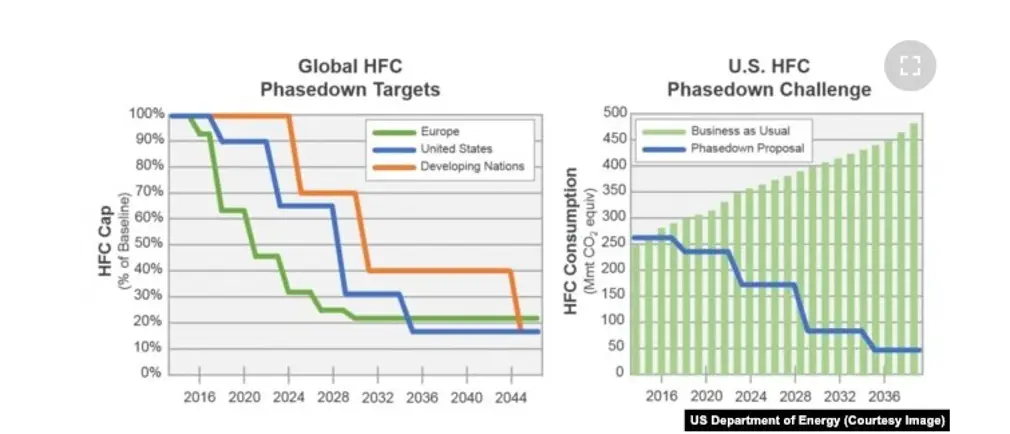The AIM Act of 2020 and the HFC phase-down are changing the refrigeration industry and will continue to present both challenges and opportunities for years to come. By embracing the requirements of the AIM Act and adapting to the evolving regulatory landscape, companies that use a large amount of refrigeration in their operations (such as grocery store chains, food and beverage manufacturing plants, food and beverages distribution companies, data centers, hospitals, hotels, multi-family apartment buildings… can position themselves for long-term success in a sustainable and environmentally conscious market. Here’s what you need to know:
What is the AIM Act?
The American Innovation and Manufacturing (AIM) Act of 2020 and the subsequent HFC phasedown are crucial steps in U.S. climate policy to reduce greenhouse gas emissions and combat global warming. The AIM Act is a U.S. federal law enacted on December 27, 2020, as part of the Consolidated Appropriations Act, 2021. Its primary objective is to phase down the production and consumption of hydrofluorocarbons (HFCs) such as HFC-227ea, HFC-125, R143a, and R407A, in various industries in the United States.
Key Provisions of the AIM Act:
- Phase-Down Schedule: The AIM Act sets forth a gradual phase-down schedule for HFC production and consumption in the U.S. The phase-down targets are based on a baseline and are expressed as a percentage reduction over specific time periods.
- EPA Regulations: The U.S. Environmental Protection Agency (EPA) is tasked with implementing and enforcing the AIM Act. The EPA will establish regulations, including allowances for HFC production and consumption, to ensure compliance with the phase-down schedule.
- Transition to Alternatives: The AIM Act promotes the transition to alternative refrigerants with lower GWPs by supporting research, development, and deployment of new technologies. This includes funding for R&D and technical assistance for industry stakeholders.
- Reporting and Recordkeeping: Manufacturers, importers, and exporters of HFCs are required to report their production, imports, and exports to the EPA. Recordkeeping is also mandated to track the sale, distribution, and use of HFCs.
- Penalties for Non-Compliance: The AIM Act authorizes the EPA to impose civil penalties for violations of the law, including non-compliance with phase-down requirements, reporting and recordkeeping obligations, and other provisions.
The phase-down of HFCs is driven by concerns about their significant contribution to global warming when released into the atmosphere.
Hydrofluorocarbons (HFCs) are synthetic greenhouse gases composed of carbon, hydrogen, and fluorine, exclusively of human origin and absent in nature. They function as refrigerants in appliances like refrigerators and air conditioners to facilitate cooling. In the past, chlorofluorocarbons (CFCs) were utilized as refrigerants, leading to ozone layer depletion and eventual phase-out under the 1987 Montreal Protocol. HFCs replaced CFCs, being ozone-friendly but possessing a warming potential up to 9,000 times greater than carbon dioxide
Impacts and Benefits of the AIM Act:
- Environmental: The phasedown of HFCs will lead to a significant reduction in greenhouse gas emissions, helping to mitigate climate change and reduce global warming.
- Economic: The transition to alternative refrigerants will stimulate innovation, create new job opportunities, and drive economic growth in the clean energy sector.
- Technological: The AIM Act encourages the development and adoption of advanced, energy-efficient technologies that use low-GWP refrigerants, benefiting both consumers and businesses.
GWP and Why It Matters
The Global Warming Potential (GWP) of hydrofluorocarbons (HFCs) varies depending on the specific type of HFC. GWP is a measure of how much heat a greenhouse gas traps in the atmosphere over a specific period compared to carbon dioxide (CO2), which has a GWP of 1 for that same period. HFCs are synthetic greenhouse gases used primarily in refrigeration, air conditioning, heat pumps, and other applications.
Here are some common HFCs and their respective GWPs over a 100-year timeframe:
- HFC-23 as a GWP of 14,800
- Freon™ 404A as a GWP of 3920
- Freon™ R-407A as a GWP of 2,107
- HFC-410A: GWP of approximately 2,088
- HFC-227 as a GWP of 3220
- HFC-125 as a GWP of 3500
- R143a, as a GWP of 1430
- By comparison, natural refrigerant CO2, as a GWP of 1
It’s important to note that these GWPs are significantly higher than that of carbon dioxide (CO2). For example, HFC-404A has a GWP that is almost 4,000 times higher than CO2 over a 100-year period.
CO2 is a natural, high-efficiency, ultra-low GWP alternative refrigerant that the EPA highly recommends. Coolsys has installed 200+ CO2 systems, including some of the largest transcritical, CO2 systems in the US. Coolsys also has 450+ CO2-trained technicians who help maintain over 600 systems nationwide. CO2 refrigerant systems are becoming a bigger part of the industry, and CoolSys is leading the charge.
Global HFC Phasedown Regulations
Both the United States and the European Union have implemented schedules to reduce the production and consumption of hydrofluorocarbons (HFCs) as part of their efforts to combat climate change and meet international commitments. Below are the key details of the HFC production reduction schedules for both the US and EU:
United States – HFC phasedown Schedule
The American Innovation and Manufacturing (AIM) Act, enacted in 2020, sets forth a phasedown schedule for HFC production and consumption in the United States. The phase-down targets are based on a baseline established for the years 2011-2013 and are expressed as a percentage reduction compared to that baseline. Here is a simplified overview of the AIM Act schedule:
- Initial Reduction: 10% reduction by 2024
- Mid-term Reduction: 40% reduction by 2029
- Long-term Reduction: 70% reduction by 2034
- Final Reduction: 85% reduction by 2036 and beyond

European Union – F-Gas Regulation Schedule
The European Union’s F-Gas Regulation has been in place since 2015 and aims to reduce the use of fluorinated gases, including HFCs. The F-Gas Regulation sets a quota system that caps the total amount of HFCs that can be placed on the EU market each year, leading to a gradual reduction in HFC production and consumption. Here is a simplified overview of the F-Gas Regulation schedule:
- Initial Reduction: 63% of the average baseline (2015-2017) by 2030
- Mid-term Reduction: 45% of the average baseline (2015-2017) by 2025
- Long-term Reduction: 31% of the average baseline (2015-2017) by 2030
Developing countries will completely freeze their use of HFCs by either 2024 or 2028, and then gradually reduce their use after that. The phase-down is critical in these emerging countries because they are at risk of becoming the highest contributors to global warming. The sales of refrigerators and air conditioners have soared in countries like China and India. Air conditioning alone is responsible for the largest growth in HFCs, according to the Berkeley National Laboratory, which estimates another 700 million air conditioners will be in use by 2030.
“Over time an astonishing array of countries – from the largest developed and emerging economies to the most poor and vulnerable states – united to take this bold step to tackle the common threat of climate change,” said Andre Light of the World Resources Institute.

Global Context – Kigali Amendment to the Montreal Protocol
Both the US and EU schedules align with the Kigali Amendment to the Montreal Protocol, an international agreement aimed at phasing down HFCs globally. The Kigali Amendment sets forth a phase-down schedule with specific reduction targets for both developed and developing countries, aiming for an 80% reduction in HFC consumption by 2047.
Reinforcing Global Reduction
The US, the EU & Developing Nations’ schedules to reduce HFC production and consumption play a crucial role in reinforcing global efforts to combat climate change and protect the environment. By setting clear targets and implementing regulations, both regions are leading by example and encouraging other countries to take similar actions.
In summary, the AIM Act and the HFC phasedown represent a comprehensive approach to addressing a major source of greenhouse gas emissions in the U.S. By setting clear targets, promoting innovation, and ensuring compliance, the AIM Act aims to protect the environment, strengthen the economy, and safeguard public health for future generations.
If your operation relies on refrigeration in any form, from freezer space to air conditioning, it is essential that transition to natural refrigerant, such as CO2 quickly to stay compliant and reduce your operating costs.
CoolSys is leading the way with designing, installing, and servicing CO2-based refrigeration systems in the US. In fact, CoolSys installed over 250 CO2 Systems, including some of the largest in the country, maintains over 600 of them, and has over 450 CO2-trained technicians across the US to ensure your systems are properly installed and maintained to maximize your investment and optimize your operations.
To learn more on how to transition to CO2 refrigerant systems with confidence and stay compliant, contact CoolSys today! We have the experience in this emerging technology to keep you ahead of the curve.



